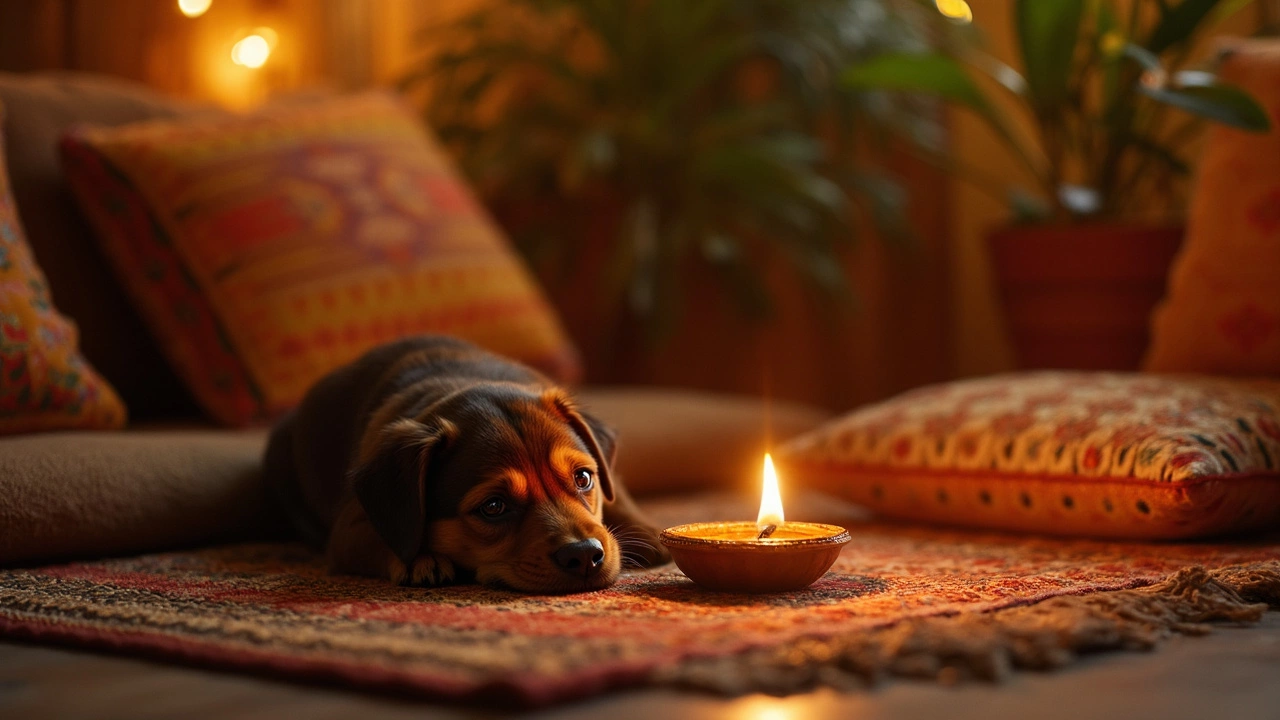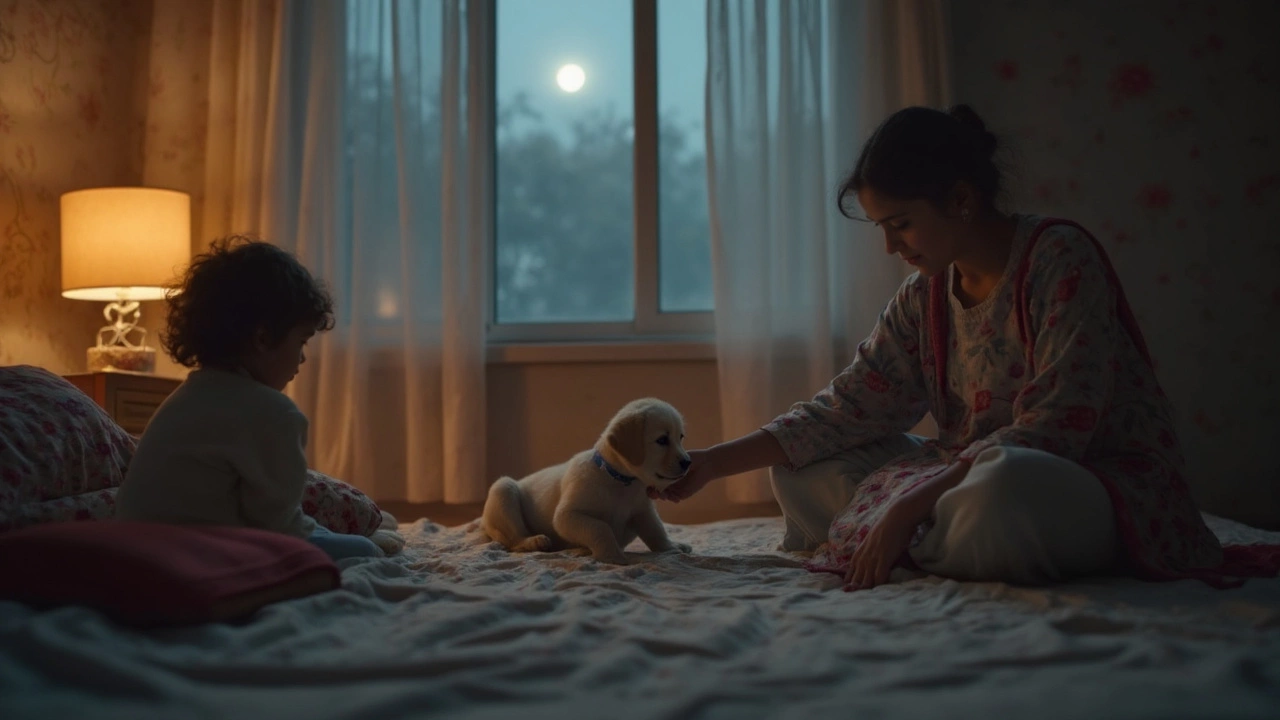
Odds are, you’ve wondered if your new puppy needs the room pitch black to sleep well. It’s not just you—this question pops up in every puppy parenting group. Is a little night light going to spoil their rest? Do puppies get scared of the dark?
Here’s the real deal: puppies don’t see darkness the way we do. Their eyes work better than ours in low light, but that doesn’t mean they want to snooze in complete blackness. In fact, a totally dark room can sometimes make them anxious in a new home. The good news? You can tweak your puppy’s sleeping setup for calmer nights without overthinking it.
Start by paying attention to how your puppy reacts at night. Are they whining or pacing when you turn off all the lights? That might be your answer right there. For most pups, a dim night light works well—especially in the first few weeks.
- Why Lighting Matters for Puppy Sleep
- How Puppies Perceive Darkness
- Health and Safety Concerns
- Night Lights: Pros and Cons
- Setting Up the Perfect Sleep Space
- Troubleshooting Puppy Nighttime Issues
Why Lighting Matters for Puppy Sleep
Light might seem like no big deal, but for a puppy, it can change the whole vibe at bedtime. Unlike grown dogs, puppies have just started figuring out their new world, and their brains haven't settled into a regular sleep rhythm yet. The right lighting helps guide your pup’s body clock, also known as their circadian rhythm.
Daylight tells your puppy’s body that it’s time to play and move. When it gets dark, their body starts making more melatonin—a hormone that signals it’s time to rest. Studies show that even a weak night light can interfere with this process, making it harder for puppies to settle down and get quality sleep. But total darkness can sometimes make them anxious, especially if they’re fresh from their litter or crate training.
Check out how lighting affects sleep quality, according to pet sleep research:
| Lighting Condition | Average Nighttime Sleep (%) | Notes |
|---|---|---|
| Natural darkness | 82% | Better deep sleep |
| Soft night light | 77% | Helps nervous puppies |
| Bright lighting | 62% | Frequent waking up |
Notice how a puppy sleep setup that’s too bright can really shave off deep rest. But a soft night light won’t do too much harm, especially for pups who seem worried in total dark. It’s all about balance—just enough comfort, not so much that you mess with their natural sleep signals.
Lights aren't just about comfort, either. Practical stuff matters too. If your pup’s getting up for potty breaks at night, a dim light helps them (and you) not trip or fumble around. In the end, paying attention to how your puppy acts with different light settings leads to better sleep for both of you.
How Puppies Perceive Darkness
Puppies experience the world differently from humans, especially when it comes to darkness. Their eyesight is built for a wider range of lighting. Puppies—and dogs in general—have more rod cells in their eyes. Rod cells are great at catching light, so your puppy can see way better than you in dim conditions. But total pitch darkness? That’s tough for them, too.
Right after birth, puppies can’t see at all. Their eyes open around two weeks old, but even then, what they see is blurry and mostly shadows. By eight weeks, their vision improves fast, but it’s still developing beyond that. They rely just as much on smell, hearing, and touch to make sense of their surroundings—especially at night.
If you compare dogs’ night vision to ours, it’s obvious why they handle low light easier:
| Feature | Puppy/Dog | Human |
|---|---|---|
| Night Vision | 6x better than humans | Standard |
| Color Perception | Sees blues/yellows best | Full spectrum |
| Adjustment to Darkness | Quick | Slower |
Even though their eyes adjust quickly to changes in lighting, a completely dark room can leave a puppy feeling disoriented, especially if they wake up and can’t sniff or hear anything familiar. You may notice some pups are totally fine in the dark, while others seem restless. That’s normal—each puppy’s comfort level is different.
If your house is noisy, or your puppy is still getting used to being away from littermates, a little light can ease anxiety. That’s why many trainers recommend a low night light, especially during the first weeks after bringing your puppy home. If your puppy sleep schedule is off, experimenting with a bit of background light might help your pup relax faster and settle in for the night.
Health and Safety Concerns
Thinking about where and how your puppy sleeps isn't just about comfort—it's also about safety and health. Puppies, like babies, get into everything. Nighttime can be risky if they’re stumbling around in pitch black, especially when they're just learning their way around your place. They might trip over toys or bump into furniture. That’s why a soft night light can help prevent minor accidents without messing with their sleep cycle.
There’s also the issue of separation anxiety. Most puppies aren’t used to being alone, and a little background light can make them feel less abandoned when you leave them for the night. This isn’t just guesswork; animal behaviorists say gentle lighting can lower stress, making your puppy settle faster. On top of that, if you’re potty training or need to check on your puppy overnight, a faint light stops you (and them) from crashing into things.
Some puppy owners worry that any light at night messes with sleep. But here’s what’s interesting: research from the American Kennel Club (AKC) says dogs don’t react to artificial light the same way we do. Pups fall asleep just fine with a night light, and their sleep cycles aren’t ruined by a faint glow. Total darkness isn't a must for healthy sleep—the real trouble is too much noise or a room that's too hot or cold.
| Risk Factor | With Total Darkness | With Dim Night Light |
|---|---|---|
| Tripping/Bumping Into Objects | High (especially for young pups) | Low |
| Separation Anxiety | Can be Worse | Often Reduced |
| Owner’s Nighttime Checks | Harder and Risky | Easier and Safer |
| Disrupted Sleep (from light) | Unlikely (unless other issues) | Unlikely (if dim) |
If your main goal is safety and relaxed, healthy sleep, a dim night light usually gives you the best of both worlds. Just make sure to place it close to the ground and away from any chew zone, because puppies really will chew anything—even the light itself.
- Use a plug-in night light with a solid cover, so no wires are exposed.
- Don’t use blinking or color-changing lights. These just distract or alarm your puppy.
- Check that the temperature in your puppy’s sleep area stays comfortable—between 68°F and 72°F works for most breeds.
Bottom line? When it comes to puppy sleep, a little light goes a long way for both health and safety.

Night Lights: Pros and Cons
The debate around leaving a night light on for puppies is real, especially for new pet parents. Let’s break down the upsides and downsides so you can make the best call for your little buddy.
Puppy sleep is a big deal. Some folks swear by night lights for easing puppy anxiety, while others worry about messing up their sleep routine. Here's the stuff that really matters:
- Pros:
- Reduces anxiety: A soft light sometimes helps new puppies settle down, especially during those first nights away from their litter.
- Helps with midnight potty breaks: A little light lets your puppy find their water bowl or potty pad, so there are fewer accidents and less confusion if you have to get up at 2 a.m.
- Makes humans' lives easier: If you’re stumbling into the room at night, a night light keeps you from tripping over the crate.
- Cons:
- Possible sleep disruption: Bright light can throw off your puppy’s internal clock (their "circadian rhythm") and make sleep harder for some pups.
- Habit-forming: Some puppies get used to the night light and might have trouble sleeping without it later on. Not all, but it's something to watch for.
- Can attract bugs: Lights, even small ones, can attract insects—annoying for everyone.
Quick heads-up on brightness: research on animals shows that dim light (under 5 lux, which is about what you get from a soft night light) has minimal effect on sleep rhythms. Here’s a handy breakdown:
| Light Level | Lux Value | Common Source |
|---|---|---|
| Total darkness | <1 | No lights |
| Very dim | 2-5 | Night lights |
| Room light | 50-100 | Reading lamp |
For most puppies, a low-glow plug-in LED night light hits the sweet spot. Avoid blue or bright white lights, since these mess with sleep the most. Go for warm white or amber shades instead. The key is to keep it cozy, not blinding.
Setting Up the Perfect Sleep Space
Creating the right sleep spot for your puppy makes a huge difference. The goal is to help them feel safe and settled, especially at night when the house gets quiet and weird shadows pop up. Here’s what actually works in real homes, based on what trainers and vets recommend.
- Location: Set up the bed in a low-traffic, draft-free spot. Avoid putting it right by a window where streetlights or headlights can flash in your pup’s face. Kitchens and hallways aren’t great—too noisy and too many smells.
- Bedding Choice: Go for a washable puppy bed or crate mat. Steer clear of old towels or piles of blankets that can bunch up or get chewed. A firm, supportive surface helps your puppy's bones and joints as they grow.
- Crate or Playpen: Many experts suggest starting with a crate or small playpen, lined with cozy bedding. This makes your pup feel more den-like and protected. Most puppies will settle better and sleep longer in a space they can call their own.
- Lighting: For the first month or so, consider using a dim LED night light. Research shows that a small light source (less than 10 lux, which is about as bright as a candle across the room) won’t mess up your puppy’s sleep cycle, but it does help if they wake up and feel disoriented.
- Noise Levels: Toss a white noise machine nearby if your house gets loud at night. Puppies can startle at unexpected sounds, and constant quiet hum helps block weird creaks or random cars outside.
If you want some hard numbers, check out how puppy sleep setups compare:
| Setup | Avg. Uninterrupted Sleep (hrs) | Restlessness |
|---|---|---|
| Pitch Black Room | 5 | Medium |
| Dim Night Light | 6-7 | Low |
| Bright Room | 4 | High |
One common mistake is going overboard with comfort items. Limit toys in the crate and stick to one or two plushies or chew-safe teething toys. Too much can rile a puppy up when you want them to wind down.
If your dog keeps waking up, double-check the temperature too. Puppies sleep best when it’s about 68-72°F (20-22°C). Too hot or too chilly, and you’ll get a restless pup.
The bottom line? Keep it simple and consistent. A snug bed, a bit of gentle light, and a quiet spot can help your puppy sleep like a champ. Change just one thing at a time if sleep still isn’t going well—puppies love predictability at night.
Troubleshooting Puppy Nighttime Issues
Even with your best efforts, some puppies just can’t seem to settle down when the lights go out. If your pup keeps crying, barking, or pacing at night, don’t lose hope. There are real reasons behind those nighttime troubles, and most have simple fixes.
First off, let’s check the basics. Did your puppy get enough exercise before bedtime? Are they hungry, thirsty, or need a bathroom break? Most restless nights trace back to one of these. Puppies have small bladders. A solid bathroom trip before bed saves a lot of drama.
If your puppy sleep issues stick around even after these basics are covered, think about their sleep setup. New puppies—especially those fresh from a litter—often feel lonely and anxious at night. A soft blanket from their breeder or a ticking clock for comfort can help. Some folks see results from placing an old, worn T-shirt in the crate. That familiar smell calms nerves.
No luck? Some pups just need a little reassuring light. A small night light, placed outside their crate but visible, might be the answer. Just don’t use anything too bright; puppies need their circadian rhythm to work properly. Studies show dogs’ sleep can be interrupted by bright lights, so keep it gentle—think dim, not daylight bright.
If your puppy has accidents at night or chews up bedding out of stress, try these extra steps:
- Stick to a bedtime routine—same time, same order every night
- Keep their bed or crate in your room for the first few weeks for extra security
- Use a pheromone diffuser marketed for puppies, which has been shown in several veterinary studies to help with nighttime anxiety
- Play soft background noise, like a white noise machine or gentle fan
How common is sleep trouble in young dogs? Here’s what recent numbers say:
| Age | Reported Nighttime Issues (by percentage) |
|---|---|
| 8-12 weeks | 61% |
| 3-6 months | 39% |
| 6-12 months | 18% |
If your puppy wakes up in a panic, stay calm. Don’t turn every night into playtime, but don’t ignore consistent distress either. Some dogs outgrow sleep struggles fast, while others need a few months. If you see signs of true separation anxiety, like non-stop barking or frantic crate escape attempts, call your vet or a certified trainer. Sometimes a pro makes all the difference.


